Beneath the bustling streets of Naples lies a captivating network of underground tunnels known as the Galleria Borbonica. With the Standard Route Entrance Ticket, visitors can descend 33 yards below ground and embark on a guided tour that unveils the remarkable history of this site. From its origins as a wastewater system to its strategic role during World War II, the Galleria Borbonica offers a unique glimpse into Naples’ past. Along the way, travelers will encounter Fascist-era statues, abandoned vehicles, and other intriguing artifacts that bring this subterranean world to life. Delve deeper into the Galleria Borbonica’s captivating narrative and uncover the surprises that lie beneath the surface.
Just The Basics
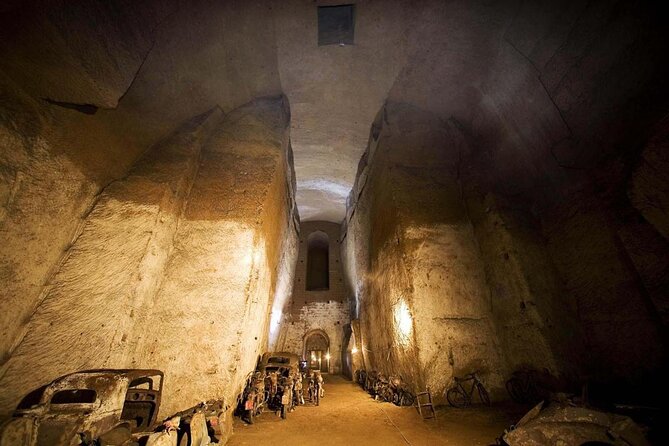
- The Galleria Borbonica standard route entrance ticket provides access to the network of underground tunnels in Naples, Italy.
- The tour offers an immersive experience, allowing visitors to explore the rich history and strategic significance of the tunnels.
- The standard route includes insights into the tunnels’ use as a shelter and military hospital during World War II.
- Visitors can discover remnants of the Fascist period, including statues and propaganda, within the tunnels.
- The standard route showcases a collection of historic cars, providing a glimpse into Naples’ automotive history.
Exploring the Galleria Borbonica
One can descend 33 yards beneath the surface to explore the Galleria Borbonica, an extensive network of underground tunnels in Naples, Italy.
Visitors can learn about the tunnels’ rich history, which includes serving as a military hospital during World War 2, and see fascinating artifacts such as air bomb shelters, statues from the Fascist period, and historic cars.
Guided tours provide an opportunity to explore the captivating past of this underground marvel, offering insights into its strategic and historical significance.
The Galleria Borbonica offers a unique and immersive experience, allowing travelers to step back in time and uncover the hidden stories that lie beneath the streets of Naples.
Here are more great tours and experiences we've reviewed in Naples
History of the Underground Tunnels
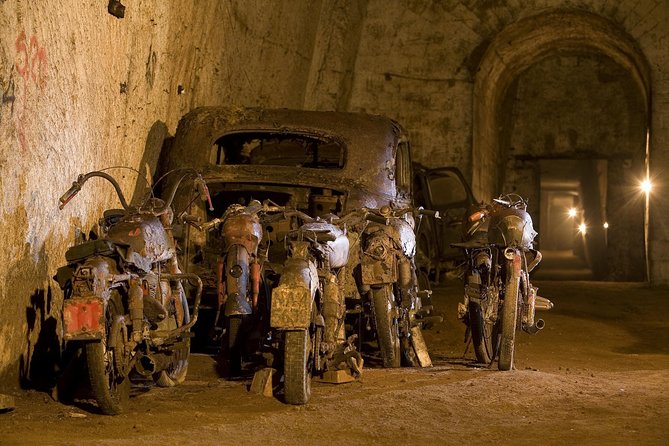
The Galleria Borbonica‘s underground tunnels have a rich history, dating back centuries and serving a variety of strategic purposes over time.
Initially constructed as a wastewater drainage system in the 16th century, these expansive tunnels later played a crucial role during times of conflict, becoming a shelter and hospital during World War II.
Descending 33 yards beneath the surface, visitors can explore the tunnels and discover remnants from this fascinating past, including an air bomb shelter and statues from the Fascist period.
The tunnels have withstood the test of time, offering a glimpse into Naples’ storied past and the city’s resilience in the face of adversity.
World War 2 Military Hospital
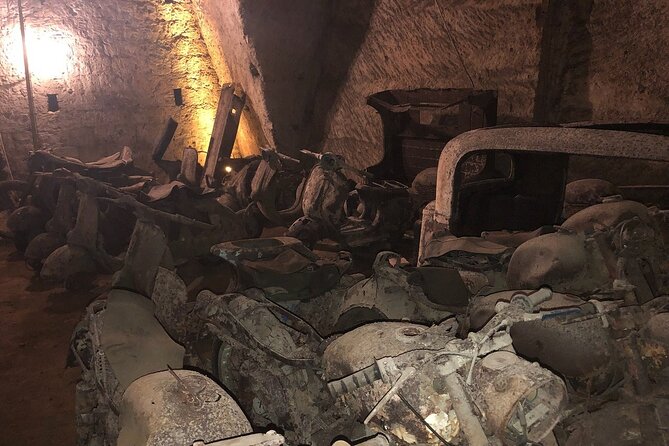
During World War II, the expansive Galleria Borbonica tunnels were repurposed as a vital military hospital, offering shelter and medical care to those affected by the conflict.
The underground corridors, once used for transportation, became a sanctuary for soldiers and civilians alike. The damp, dimly lit spaces were transformed into wards and operating theaters, as medical personnel worked tirelessly to treat the wounded and sick.
Remnants of this historic role can still be seen today, with abandoned medical equipment and supplies scattered throughout the tunnels. Visitors can gain a profound appreciation for the resilience and sacrifice of those who sought refuge and treatment within these subterranean chambers during the tumultuous war years.
Descending Into the Air Bomb Shelter
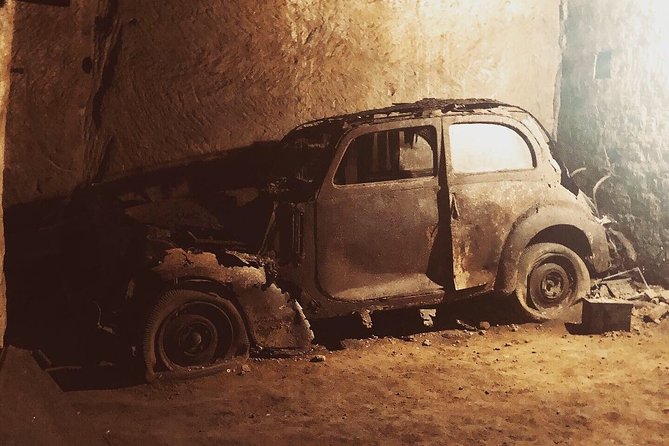
Descending 33 yards beneath the surface, visitors encounter the Galleria Borbonica’s air bomb shelter, a testament to the city’s wartime resilience.
This cavernous space, once a refuge from the devastation of World War II, now stands as a poignant reminder of Naples’ stoic determination.
Exploring the shelter, visitors can imagine the huddled figures seeking sanctuary from the aerial bombardments that rained down upon the city.
The shelter’s sturdy construction and meticulous design underscore the ingenuity and foresight of those who built it, ensuring the survival of the local populace even in the darkest of times.
This historic site offers a powerful connection to the past, allowing visitors to walk in the footsteps of those who endured the trials of war.
Fascist Period Statues and Artifacts
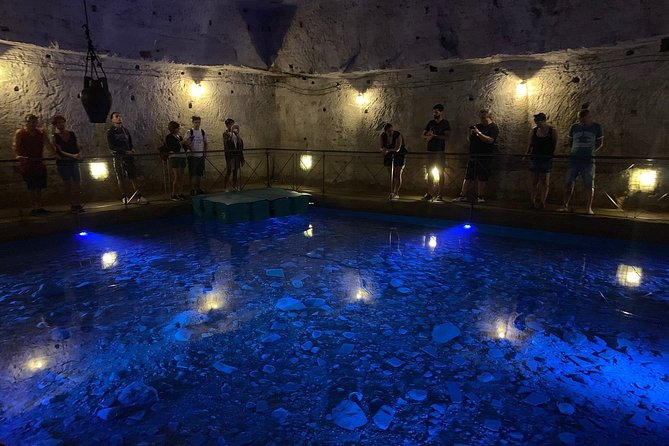
Visitors who delve deeper into the Galleria Borbonica uncover a trove of statues and artifacts dating back to the Fascist period, offering a captivating glimpse into Naples’ turbulent history.
Among the notable finds are:
Marble busts and statues of Mussolini and other Fascist leaders, standing as reminders of the regime’s pervasive influence.
Fascist propaganda posters and banners, showcasing the powerful visual language used to sway public opinion.
Remnants of military equipment and vehicles, echoing the Galleria’s role as a wartime hospital and shelter.
These artifacts shed light on a complex and often controversial era, inviting visitors to reflect on the region’s complex past.
- Pompeii Vesuvius Day Trip From Naples+Italian Light Lunch
- From Naples: Pompeii Entrance & Amalfi Coast Tour With Lunch
- Day Trip From Naples: Amalfi Coast Tour Including Ravello
- Ten Thousand Islands Boat Tour up to 12 People
- Kayak Tour Adventure Marco Island and Naples Florida
- Marco Island Wildlife Sightseeing and Shelling Tour
Viewing the Historic Cars

As visitors delve deeper into the Galleria Borbonica, they’re greeted by a collection of historic cars, remnants of Naples’ automotive past. These vintage vehicles, some dating back to the early 20th century, offer a captivating glimpse into the region’s transportation history.
Tucked away in the dimly lit tunnels, these cars have been preserved, allowing visitors to admire their classic designs and imagine the stories they could tell. Exploring these relics transports guests back in time, fostering a deeper appreciation for Naples’ rich cultural heritage.
The opportunity to witness these automobiles up close is a unique highlight of the Galleria Borbonica tour, leaving visitors with a lasting impression of the city’s fascinating past.
Tour Inclusions and Meeting Point
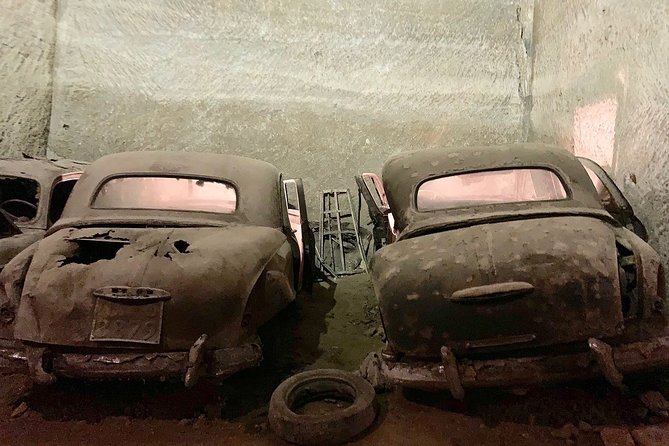
The Galleria Borbonica tour includes a professional guide, who can provide commentary in either English or Italian, as well as the entrance ticket to explore the historic underground tunnels. Travelers will meet at the Galleria Borbonica’s main entrance, located at Vico Grottone, Vico del Grottone, 4, 80132 Napoli NA, Italy. At the end of the tour, visitors will return to the same meeting point.
It isn’t wheelchair accessible, so comfortable shoes and a sweater are recommended.
Discounted tickets are available for those over 75 and ages 11-13, while children under 10 can enter for free.
Each tour is limited to a maximum of 50 travelers.
Cancellation Policy and Additional Information
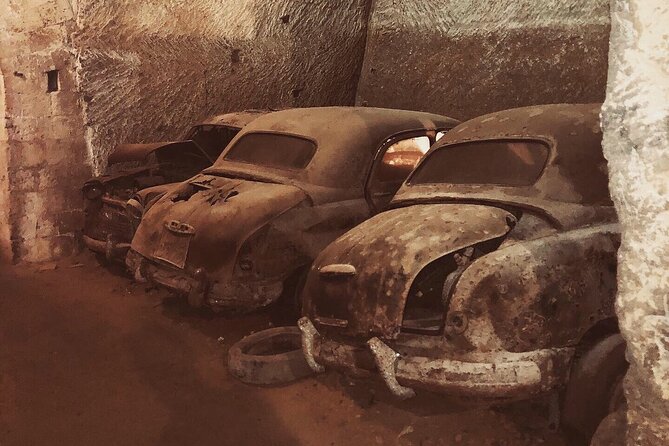
You can cancel up to 24 hours in advance for a full refund, but if you cancel less than 24 hours before the experience, you won’t receive a refund.
The tour isn’t wheelchair accessible, so be sure to wear comfortable shoes and a sweater.
There’s a reduced price of €5 for those over 75 and ages 11-13, while kids under 10 get in for free.
The tour has a maximum of 50 travelers, so book early to secure your spot.
The Galleria Borbonica is an underground tunnel, so you’ll be descending 33 yards beneath the surface to explore its historic air bomb shelter, statues from the Fascist period, and vintage cars.
Frequently Asked Questions
Is the Tour Available in Other Languages Besides English and Italian?
The tour is primarily offered in English and Italian, as these are the main languages spoken by the professional guides.
However, the operator may be able to accommodate other languages if requested in advance, subject to guide availability.
Visitors are encouraged to inquire about language options when booking the tour to ensure they can participate in their preferred language.
Can I Bring My Own Food and Drinks Into the Tunnels?
Yes, visitors can bring their own food and drinks into the Galleria Borbonica tunnels.
However, it’s important to be mindful of any rules or restrictions regarding consumption and waste disposal within the historic site. Guests should aim to keep the tunnels clean and preserve the integrity of the space.
Enjoying a snack or beverage during the tour can enhance the experience, but responsible behavior is expected from all visitors.
Are There Any Age Restrictions for the Tour?
Yes, there are some age restrictions for the Galleria Borbonica tour.
Children under 11 years old can enter for free, while those aged 11-13 receive a discounted rate of €5.
The tour isn’t recommended for young children as the underground tunnels may be challenging for them.
Is Photography Allowed Throughout the Entire Tour?
Photography is generally permitted throughout the Galleria Borbonica tour. Visitors are encouraged to capture the historic sights and unique atmosphere of the underground tunnels.
However, it’s important to be mindful of other tour participants and follow any guidelines provided by the guide.
Some areas may have restrictions, so it’s best to ask the guide about photography policies at the start of the tour.
How Long Does the Tour Typically Last?
The Galleria Borbonica tour typically lasts around 1 hour. Visitors will spend this time exploring the underground tunnels, learning about their fascinating history, and seeing sights like an air bomb shelter, statues from the Fascist period, and historic cars.
The guided tour provides an immersive experience as you descend 33 yards beneath the surface, so guests should expect to be on their feet for the duration of the visit.
Sum Up
The Galleria Borbonica in Naples offers a captivating glimpse into the city’s storied past.
Descending 33 yards below the surface, visitors can explore the extensive network of underground tunnels, uncovering their rich history as a wastewater drainage system, military hospital, and air raid shelter during World War II.
The guided tour provides an immersive experience, showcasing Fascist-era statues, historic cars, and the strategic significance of this remarkable site.
More Tickets in Naples
- Herculaneum With Priority Ticket and Audio Guide!
- Naples Skip-the-Line San Martino National Museum and Charterhouse Ticket
- Ischia Poseidon Gardens Entry Ticket With Hydrofoil Transfer
- Naples: Pompeii and Amalfi Coast Day Trip With Ticket Option
- Naples: Herculaneum Entry Ticket With Digital Audio Tour
- Excavations of Herculaneum. Tour Guide and Skip-The-Line Ticket
More Tour Reviews in Naples
Not for you? Here's more things to do in Naples we have recnetly reviewed
- From Naples; Caserta Palace Ticket and Train With Audioguide
- Naples: Pasta Making Class With Starter and Drink
- Napoli: Half-Day City Sightseeing Group Tour
- Napoli – Food Art Tour: Explore Street Flavors
- Naples: the Magic of Christmas and Nativity Scenes
- Mount Vesuvius From Naples: Bus, Ticket and Audio Guide
- Naples: Full-Day Electric Bicycle Rental
- Naples: Veiled Christ Guided Tour and Ticket
- Naples: Historical and Street Art Walking Tour
- Naples: Herculaneum Entry Ticket With Digital Audio Guide
- Naples: Royal Palace Entry Ticket With Digital Audio Guide
- Naples: Walk Through the Citys Alleys With Local Guide
